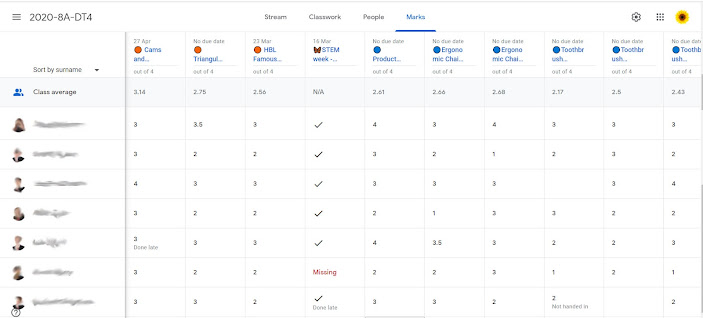Blended Assessment in D&T
The introduction of blended learning into my classroom and then the abrupt switch to a virtual learning curriculum has had a huge impact on how I now assess students through both formative and summative assessment.
I’m very
interested in exploring how digital tools can help alleviate the time pressures
and work load of marking on the teacher whilst providing students with
personalised, targeted feedback that leads to exceptional progress.
“feedback should cause thinking.
It should be focused; it should relate to the learning goals that have been
shared with the students; and it should be more work for the recipient than the
donor. Indeed, the whole purpose of feedback should be to increase the extent
to which students are owners of their own learning,”
― Dylan Wiliam, Embedded Formative Assessment
KS3 Digitally
Marked Scheme of Learning
The
majority of formative assessment during a KS3 DT rotation has historically been
in the form of handwritten comments. I’ve also tried my hand at integrating
marking boxes into worksheets and booklets, designing stickers for common
misconceptions or common mistakes and a wide range of peer and self-assessment
tasks, games and quizzes.
In one of
my schemes of learning that I have created for my department, I now use a
completely blended approach to formative assessment using google classroom’s
mark book to track students progress through the rotation (or scheme of
learning). Students still use a booklet but it no longer tells the whole story.
Several pieces of work are still booklet based and require handwritten work
and/or hand drawing techniques. Students simply photograph their work and
submit it on a google classroom assignment. I do not ask students to
upload every page of the booklet as some are still self - marked quizzes or
peer assessed pieces. I have created rubrics for each piece of work that
requires teacher feedback. Rubrics have enabled me to speed up my feedback
process. Each student is given a mark out of 4 which directly correlates to
‘Emerging, Developing, Securing and Mastering’. Any student who would be
classed as ‘below expectation’ or ‘exceptional performance’ would have a
specific comment alongside their rubric comment explaining why this is. I can
also give specific personalised comments to students who I believe need further
feedback that is not covered by the rubric.
Example mark-book using the 1-4 system and
rubrics. Tip: Use emojis to distinguish
between different units of work and/or special one off lessons. eg.
The STEM week lesson above.
Students
then ‘reAct’ to their online feedback using a green post-it note they can stick
into their books. This consolidates the feedback and imbeds the learning.
Examples
of ReAct post-it notes being used to consolidate and implement feedback.
As I
mentioned previously the booklet is not the full story and students can now
have videos, photographs, CAD files and other digital forms of work stored and
assessed alongside their written work. This is invaluable in a subject such as
Design Technology due to the practical element of each scheme of learning and
is particularly useful for recording and assessing physical pieces that have
moving parts. There are also other types of formative assessment that I use
regularly in lessons such as quizziz and kahoot for quick fire fun quizzes and padlet
for a wide range of different ways to formatively assess. (See blog post ‘Using
Padlet’). All of these other forms of blended learning/ assessment can be
integrated into google classroom and recorded as part of the learning journey
through the unit of work.
2. An example of summative assessment
at the end of DT rotation. The student has reflected on her online feedback and
put the final assessment into her own words.
This
scheme of learning is now taught by two other members of staff who I have
introduced to my assessment methods outlined above. I am really looking forward
to hearing from them at the end of this year’s first rotation to hear how they
have found using this blended assessment approach and if, like me, they have
found it beneficial.
Using Padlet
Another blended approach to formative assessment I have
fallen in love with is the use of Padlet.
In my
lessons as a DT and Art teacher I very often use Padlet as it is a fantastic
resource for showcasing visual work. I have also used Padlet to aid with peer
assessment, to play ‘guess who’ games, and to offer a forum for quick fire
questions with 6th form. I also used it for starter activities
within google meets during the periods of school closure; posing a question
that students could respond to whilst they waited for others to join the
meet.
The Padlet page below was used for peer assessment with a year 8 Art class. Students were to follow the assessment criteria also posted on the page. https://padlet.com/barrowt/y14ullp1gjc1h2ke This enabled the whole class to see the peer assessment of other pairs and enabled me to have this on the board and discuss their assessments as a whole class – offering thoughts and questioning on what made a successful drawing and what was a successful peer assessment comment.
Blue Hearts for the NHS blogpost: https://barrowt.blogspot.com/2021/02/blue-hearts-for-nhs.html?spref=tw
I have thoroughly enjoyed learning about the different ways we can utilize Edtech to enable students to get timely, effective formative and summative assessment. I want to continue to explore this area and continue to share my ideas/findings with colleagues. I am currently attached to the Ridgeway Academy in an SLE capacity. I am excited to work alongside them when they start to role out ‘bring your own device’. I look forward to discussing the benefits of digital assessment methods and how we can assess practical and visual subjects.
Further Reading:
https://www.raconteur.net/digital/changing-role-teacher/
https://www.bookwidgets.com/blog/2017/08/30-creative-ways-to-use-padlet-for-teachers-and-students







